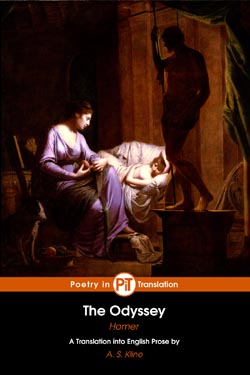Homer: The Odyssey
A complete English translation with hyper-linked index and illustrations by Theodoor van Thulden (Dutch, 1606-1669) courtesy of the Rijksmuseum

I will endure it, owning a heart within inured to suffering.
For I have suffered much, and laboured much,
in war and on the seas: add this then to the sum.
- Home
- Browse below
- Download
- Buy This Book
Book I: Athene visits Telemachus
Book II: Debate in Ithaca
Book III: Telemachus in Pylos
Book IV: Telemachus in Lacedaemon
Book V: Odysseus and Calypso
Book VI: Odysseus and Nausicaa
Book VII: Odysseus meets Alcinous
Book VIII: The Games in Phaeacia
Book IX: Polyphemus the Cyclops
Book X: Odysseus and Circe
Book XI: Odysseus in the Underworld
Book XII : Scylla and Charybdis
Book XIII: Odysseus in Ithaca
Book XIV: Odysseus and Eumaeus
Book XV: Telemachus Returns
Book XVI: Odysseus and Telemachus
Book XVII: Odysseus in the palace
Book XVIII: Irus the beggar
Book XIX: Odysseus and Eurycleia
Book XX: Preparations for revenge
Book XXI: The archery contest
Book XXII: The fight in the palace
Book XXIII: Odysseus and Penelope
Book XXIV : Athene makes peace
The Text is fully hyper-linked to the index and vice versa.
Each Book is arranged in paragraphs, with each paragraph headed by the corresponding line reference in the Greek text.
About This Work
The Odyssey, the second of the epic texts attributed to Homer, and also a major founding work of European literature, is usually dated to around the 8th century BC. It is an epic poem, effectively a sequel to the Iliad, written in Ancient Greek but assumed to be derived from earlier oral sources, telling the story of Odysseus’ wanderings and his eventual return from the Trojan War to his home island of Ithaca. The cultural background to the poem indicates a Bronze Age setting around 400 to 500 years before the Homeric literary period itself. The poem contains elements of myth and legend as well as sheer literary invention, and covers the ten years of its hero’s adventures from the destruction of Troy to his return to his wife Penelope and son Telemachus. Of particular interest is the role of women in the Bronze Age culture described, represented in a sense by Odysseus’ guardian deity, Athene, the goddess of mind. Odysseus is an archetype of the person of intellect who uses brains and eloquence rather than brawn to outwit opponents and impress peers, and therefore sets the scene for later Greek Classical culture.
About the Author
The true authorship and dating of the Odyssey and the other great poem attributed to Homer, the Iliad, has been much disputed. The consistency of language and treatment lends itself to the view that a single author Homer created, or at least consolidated and edited, the literary material. This was the view of ancient Greek authorities, though they differ widely on the question of who Homer was, and at what period he lived. Many mythical elements gathered around the name Homer, until the image of a blind bard from the island of Chios gained prominence, despite there being no evidence of his blindness or his bardic wanderings, and despite many places claiming to have been his birthplace or residence. Equally there is no absolutely definitive text rather the currently accepted text is the result of the work of many editors over a long period of time, from at least the 3rd century BC to modern times. There is much fascinating and erudite scholarship concerning the Homeric ethos, involving literary, linguistic, cultural, archaeological, and other evidence, and debate is ongoing. However the issue of literary authorship in no way detracts from the power and integrity of the epic poems themselves.
Translated by A. S. Kline © Copyright 2004 All Rights Reserved
This work may be freely reproduced, stored and transmitted, electronically or otherwise, for any non-commercial purpose. Conditions and Exceptions apply.
Last Modified 8 December 2004